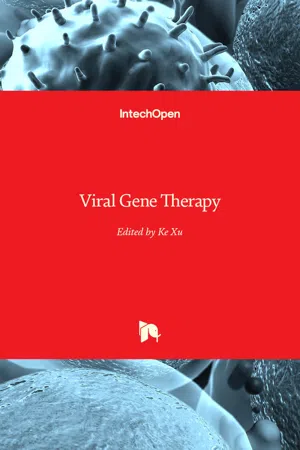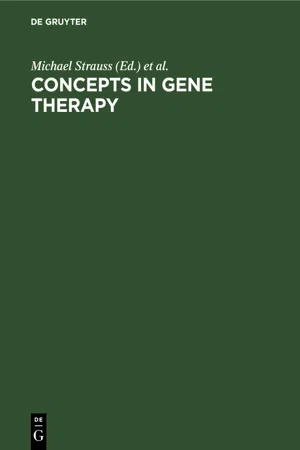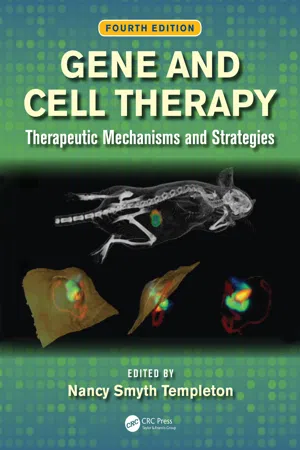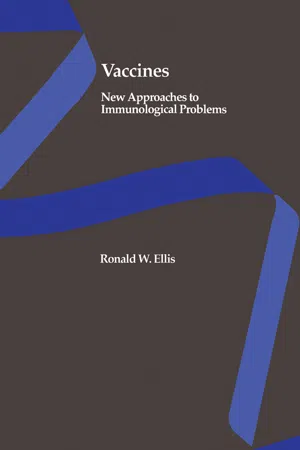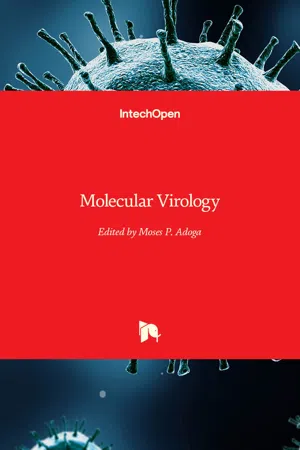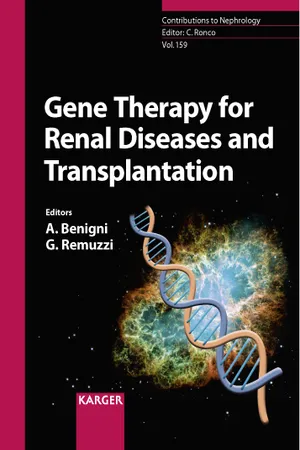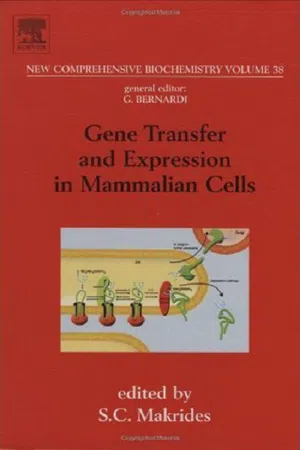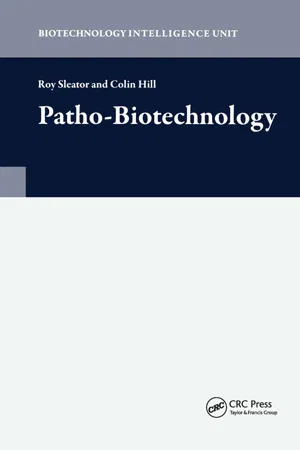Biological Sciences
Adenovirus Vector
Adenovirus vectors are genetically engineered viruses that are used as delivery vehicles for gene therapy and vaccine development. They are modified to be safe and non-replicating, allowing them to efficiently deliver genetic material into target cells. Adenovirus vectors have shown promise in various medical applications due to their ability to induce strong immune responses and deliver therapeutic genes.
Written by Perlego with AI-assistance
Related key terms
1 of 5
10 Key excerpts on "Adenovirus Vector"
- eBook - PDF
- Ke Xu(Author)
- 2011(Publication Date)
- IntechOpen(Publisher)
Part 2 Adenoviral Vector 5 Adenoviral Vectors: Potential and Challenges as a Gene Delivery System Suresh K. Mittal, AnneMarie Swaim and Yadvinder S. Ahi Department of Comparative Pathobiology, Purdue University Center for Cancer Research, and Bindley Bioscience Center, Purdue University, West Lafayette, IN, USA 1. Introduction Adenoviruses (AdV) have been well delineated and made into suitable vectors for gene transfer by their somewhat benign nature, broad tissue tropism, and the relative ease of manipulation of their genome. These viruses readily transduce both quiescent and dividing cells, are adaptable for large scale production and have certified cell lines that have been developed for purification. Nevertheless, these vectors are not recommended for all purposes. Currently, adenoviral vectors are more widely evaluated in applications where a short-term transgene expression is sought after (i.e., cancer and vaccines) (Jolly et al., 2008; Sharma et al., 2009b). Rowe and colleagues in 1953 were the first to isolate AdV from adenoidal tissue and to describe the spontaneous degeneration of primary cell lines from whence they were derived (Rowe WP et al., 1953). A similar virus was isolated from an epidemic of respiratory illness in U.S. military recruits in 1954 (Hilleman MR & Werner JH, 1954). In 1956, the viruses were named adenoviruses after the tissue from which they were isolated (Enders et al., 1956). Their anti-tumor potential was explored in the clinical treatment of cervical carcinoma following AdV inoculation not long after 1956 (Huebner et al., 1956). Despite this initial use, it took several years following the advent of recombinant technology before the therapeutic potential of AdV was truly realized. Since then, adenoviral vectors have received much attention as gene transfer agents and currently are being tested in a wide variety of gene therapy applications. - eBook - PDF
- Roland W Herzog, Sergei Zolotukhin(Authors)
- 2010(Publication Date)
- World Scientific(Publisher)
Chapter 2 Adenoviral Vectors Stuart A. Nicklin ∗ and Andrew H. Baker Adenoviruses are one of the most widely investigated vectors for gene therapy. Their attributes include ease of genetic manipulation to produce replication-deficient vectors, ability to readily generate high titer stocks, efficiency of gene delivery into many cell types and ability to encode large genetic inserts. Adenoviruses have been utilized for a variety of therapeutic applications particularly for high level transient overexpres-sion in cancer gene therapy, vaccine delivery and certain cardiovascular diseases. With the first licensing of clinical adenoviral gene therapy for cancer treatment the use of adenoviruses is likely to expand in the future. This chapter focuses on the history of adenovirus development, interac-tions with the host both for gene delivery and immunogenicity as well as potential therapeutic applications. 1. Introduction The human adenovirus (Ad) family is divided into 6 sub-species (A-F). There are a total of 51 different serotypes identified to date, classified via differential abilities to hemagglutinate erythrocytes and characterized by differences in capsid structure and receptor use. Ads from species C, partic-ularly serotype 5 (Ad5) are the most widely investigated viral gene transfer vectors and consequently, one of the most commonly utilized viral vectors in clinical trials. However, it is only in recent years that important findings regarding receptor usage and interactions with the host in vivo , particularly following intravenous (i.v.) administration, have been deciphered. There are ∗ Correspondence: BHF GCRC, Faculty of Medicine, University of Glasgow, 126 University Place, Glasgow UK. E-mail: [email protected] 21 - eBook - PDF
- Michael Strauss, John A. Barranger, Michael Strauss, John A. Barranger(Authors)
- 2020(Publication Date)
- De Gruyter(Publisher)
2. Adenoviral Vectors Patrice Yeh, Jean-François Dedieu, Emmanuelle Vigne, Cécile Orsini and Michel Perricaudet In the last decade, defective recombinant adenoviruses have emerged as potent vehi-cles for direct in vivo gene delivery in a number of adherent somatic and tumor cells. Since 1993, they are being evaluated in phase I clinical trials that target cancer or hereditary diseases. Preclinical and clinical data indicate that humoral and cellular immunity to the virus and the virus-infected cells represent recurring issues that must be answered for safe and effective adenovirus-based therapies. The exhaustive anal-ysis of the host response to El-deleted vectors is indeed required. We will review here the basic features of the virus biology, together with the rationale underlying current anti-inflammatory strategies that are being developed for gene transfer, and hopefully therapy, with a clinical grade vector. 2.1 Adenoviruses Adenoviruses (Ad) have been isolated from man to bird. 47 human serotypes have been identified which are classified into 6 subgroups (A to F). They are mostly as-sociated with acute respiratory infections, epidemic conjunctivitis and infantile gas-troenteritis (36). Certain human serotypes are tumorigenic in newborn rodents, but attempts to establish them as a causative agent in human cancer have been uniformly negative. In fact, several serotypes have been used with an excellent safety profile as live enteric vaccines (62). This is the case for serotypes 2 (Ad2) and 5 (Ad5), two closely related, non tumorigenic, adenoviruses belonging to subgroup C. The biology of these viruses has been extensively studied, especially with regard to their oncogenic potential and the various cellular regulation mechanisms they target to re-focus gene expression for their own purpose (for a review see (63). The nucleotide sequence of Ad5 is very close to that of Ad2 (14). - eBook - PDF
Gene and Cell Therapy
Therapeutic Mechanisms and Strategies, Fourth Edition
- Nancy Smyth Templeton(Author)
- 2015(Publication Date)
- CRC Press(Publisher)
In vivo gene delivery can only be successful when spatial and temporal control of transgene expression is achieved to a very large degree. Vectors must be developed that efficiently reach and transduce their target cells and are devoid of inter-actions with nontarget cellular and noncellular compartments while finding their way into the target cells. To minimize dose- dependent side effects, the vectors must efficiently transduce the target cells after administration of low doses. And finally, the fate of the vector genomes inside the target cells should allow for controlled and, depending on the application, persistent trans-gene expression ideally without side effects such as genotoxicity. The multitude of interactions between adenovirus vec-tors and patients after in vivo vector delivery imposes a large number of barriers that negatively influence efficient and specific gene delivery and determine the toxicity of the vec-tors to a large degree. While clinical studies and data from animal models have already revealed a large number of such barriers, only the minority of them is understood in detail. Furthermore, it appears very likely that numerous barriers have not even been identified yet. The aim of this chapter is to outline the complexity of vector–host interactions of Adenovirus Vectors as far as possible today and to figure out the utility of chemical adeno-virus vector modifications as a tool to analyze and overcome efficacy-limiting barriers for adenovirus-vector-mediated gene transfer. 2.2 BASIC ADENOVIRUS BIOLOGY 2.2.1 C LASSIFICATION Adenoviruses were first isolated in 1953 from adenoid tis-sues [29]. They are nonenveloped viruses with an icosahe-dral protein capsid that protects a linear double-stranded DNA genome with a size of 36–40 kilobase pairs (kb). - eBook - PDF
Vaccines
New Approaches to Immunological Problems
- Ronald W. Ellis(Author)
- 2014(Publication Date)
- Butterworth-Heinemann(Publisher)
16.5 GENE TRANSFER USING Adenovirus VectorS Unlike vaccinia or herpes simplex viruses, adenoviruses have the ability to transform mammalian cells and stably integrate their DNA into the host-cell genome. Thus, vectors carrying inserts of foreign genes can be used to generate stable cell lines carrying the inserted genes along with the integrated viral DNA. The ability of the viral genome to integrate is independent of El (van Doren et al. 1984) so that vectors can be constructed which can transform many different cell types, including normally permissive (for hu-man Ads) human cell lines (van Doren and Gluzman 1984; Haj-Ahmad and Graham 1986). Adenovirus Vectors can also be used to transfer genes into cells such as hematopoietic cells that are relatively resistant to DNA-mediated transformation using the calcium phosphate technique (Karlsson 376 Adenovirus-Based Expression Vectors and Recombinant Vaccines et al. 1985). Recombinant viruses containing a selectable gene, such as the Neo r gene conferring resistance to G418, in one part of the genome and an unselected gene at another cloning site, have been used to establish per-manent cell lines in which the unselected gene is expressed in a cell type or tissue-specific manner (Karlsson et al. 1986; Ruether et al. 1986). This use of Adenovirus Vectors as transducing viruses is an area that has not yet been extensively exploited. 16.6 ADENOVIRUSES AS RECOMBINANT VACCINES: ADVANTAGES AND DISADVANTAGES 16.6.1 Safety and Efficacy as Vaccines The role of human adenoviruses, particularly types 4 and 7, as major caus-ative agents of epidemic acute respiratory disease (ARD) in military recruits and the use of vaccination to prevent this condition is well documented (Top 1975; see also review by Rubin and Rorke 1988). The vaccines, con-sisting of unattenuated Ad4 and Ad7 in enteric-coated capsules, were li-censed in 1980 for oral administration to military personnel. - eBook - PDF
- Moses P. Adoga(Author)
- 2012(Publication Date)
- IntechOpen(Publisher)
5 Viral Vectors in Neurobiology: Therapeutic and Research Applications Renata Coura Centre de Neuroscience Paris Sud – CNPS – Université Paris Sud XI France 1. Introduction 1.1 History and definition of viral vectors Viruses are intracellular parasites with simple DNA or RNA genomes (Figure 1A). Three steps compose virus life cycle: infection of a host cell, replication of its genome within the host cell environment, and formation of new virions (Figure 1B). This process is often but Fig. 1. Virus. (A) Structure. Simplified scheme of virus structure, with a lipid envelope that can be present or not; a protein-composed capsid and the genetic material, that can be DNA or RNA, double or single strand. (B) Life cycle. Example of the course of adeno-associated virus (AAV) productive infection. Scheme showing the eight steps of AAV transduction of host cells: (1) viral binding to a membrane receptor/co-receptor; (2) endocytosis of the virus by the host cell; (3) virus intracellular trafficking through the endosomal compartment; (4) escape of the virus from the endosome; (5) virion uncoating; (6) entry into the nucleus; (7) viral genome conversion from a single-stranded to a double-stranded genome; and (8) integration into the host genome or permanence of an episomal form capable of expressing an encoded gene (from Coura and Nardi, 2008). Molecular Virology 76 not always associated with pathogenic effects against the host organism. Nevertheless, since the mid-1980s, a likely useful role for virus has been envisaged. The idea is to use the unique virus capacity to enter the cell and to replicate their genome to construct vectors, containing the viral envelope and a recombinant genome, so that these vectors could be able to deliver genetic material into cells. Then, recombinant viral vectors are created in which genes essential for viral replication are removed and a gene of interest is inserted in the viral genome (Figure 2). - A. Benigni, G. Remuzzi, Claudio Ronco(Authors)
- 2008(Publication Date)
- S. Karger(Publisher)
The human Adenoviridae family is composed of more than 50 Ad serotypes (based primarily upon the lack of cross-reacting anti-body neutralization between serotypes) that are categorized into six subgroups (A–F) primarily based upon different red blood cell-agglutinating capabilities of the various subgroups. These viruses possess the natural ability to infect a wide range of cell types including both dividing and nondividing cells, can easily be produced to large scale using a cell culture-based system, and the vector genomes do not integrate into the host genome. For these reasons, amongst oth-ers, several generations of replication-deficient Ad vectors have been developed within the last two decades [reviewed in 1]. ‘First-generation’ Ads lack the E1 region of genes, a region that encodes genes essential for initiation of the viral life cycle. Removal of these genes effectively renders the virus incapable of ini-tiating efficient expression of viral genes required for Ad genome replication as Adenovirus Vectors for Renal-Targeted Gene Delivery 49 well viral structural proteins. For use as a gene transfer vector, a desired mini-gene expression cassette (containing an appropriate enhancer, promoter, cDNA construct, preferably with some intronic elements, and polyadenylation signal) can be inserted into this region allowing for its expression upon Ad-mediated transduction into targeted tissues or cells (fig. 1). In order to propagate these E1-deleted Ad vectors, the essential E1-encoded proteins are supplied in trans by transcomplementing cell lines such as HEK 293 or PER.C6. Advanced-generation vectors encompassing additional deletions in the E2b or E4 regions have also been developed. These vectors retain the capabilities of large-scale growth noted 10,000 bp 20,000 bp E2a E4 L5 L4 E3 L1 E1 L2 L3 Fiber a b Penton base Knob E2b 30,000 bp Fig.- eBook - ePub
- S.C. Makrides(Author)
- 2003(Publication Date)
- Elsevier Science(Publisher)
AAV vectors have been increasingly used for gene transfer and gene therapy, particularly in vivo, because of the safety, high efficiency and long-term gene transfer by the vector system. In vitro and in vivo gene transfer is discussed along with the immunological aspects of AAV vectors. Compared to other viral vector systems, such as those based on retrovirus and adenovirus, the AAV vector is relatively new with potential for further development. Abbreviations • AAV adeno-associated virus • Ad adenovirus • Cap AAV capsid gene • CTL cytotoxic T lymphocyte • ITR inverted terminal repeat • i.u. infectious unit • m.o.i. multiplicity of infection • Rep AAV replication gene • t.u. transducing unit • v.g. viral genome copy number 1 Biology of adeno-associated virus Adeno-associated virus (AAV) is a non-pathogenic and replication-defective member of the parvoviridae family. It is a small, non-enveloped DNA virus (Fig. 1) consisting of a single-stranded genome of approximately 4.7 kilobases (kb) and an icosahedron protein coat [ 1 ]. Currently, up to eight different serotypes of AAVs have been isolated from primates [ 2 – 11 ]. AAV has no etiological association with any known diseases. Its propagation requires the co-infection of an unrelated virus, such as adenovirus or herpesvirus, to provide essential helper functions. In the absence of a helper virus, however, AAV establishes a latent infection by integrating its DNA into the host cell chromosomes or maintaining its genome as free episomal DNA. Its latent infection life cycle provides an important basis for the use of AAV as a stable gene transfer vector, while its non-pathogenicity and replication defectiveness offer additional safety features for in vivo gene therapy applications. Fig. 1 Electron microscopy of AAV2 (panel A) and its helper virus adenovirus 2 (panel B). Note the few empty AAV particles that lack viral DNA genome and show a ring-like image - eBook - PDF
- Dr. Roy Sleator(Author)
- 2008(Publication Date)
- CRC Press(Publisher)
Current strategies to improve Ad vectors involve using transductional targeting to redirect the virus to a novel receptor, genetic modification to increase tropism and use o f alternative serotypes, including nonhuman A d .38 Again, safety issues arise e.g., due to toxicity and host immune response. Adeno-Associated Viral Vectors Adeno-associated viruses (AAVs) are small, non-enveloped, single stranded D N A viruses, belonging to the parvovirus family.42 M ost AAV vectors are derived from AAV2 but different AAV serotypes, capable o f infecting different cell types have been identified.43 This is useful, as pseudotyping AAV2 with capsids from other serotypes can be carried out. AAVs are dependent V iral Pathogens as Therapeutic D elivery Vehicles 137 on a helper virus, usually adenovirus (or herpesvirus) to replicate. In the absence o f a helper virus, AAVs integrate into (a specific location in) the genome, establishing a latent infection. The D N A genome consists o f two genes; rep , coding for proteins which control viral replication, structural gene expression and integration into the host genome and cap, which codes for capsid structural proteins. At either end o f the genome are inverted terminal repeats (ITR s/TR s), which play a role in integration and rescue o f the AAV genome and are required in cis for viral D N A replication and encapsidation. W hen used as a vector, the rep and cap genes are replaced by the transgene and its associated regulatory sequences (Fig. 5). Production o f the recombinant vector requires that rep and cap are provided in trans, along with helper virus products (from the adenovirus genome). O ne method is to cotransfect two plasmids, one for the vector and the second for rep and cap, but this method has drawbacks—low yields, contamination with adenovirus and wild type AAV. - eBook - PDF
Viral Vectors
Gene Therapy and Neuroscience Applications
- Michael G. Kaplitt, Arthur D. Loewy(Authors)
- 1995(Publication Date)
- Academic Press(Publisher)
Group C Adenoviruses as Vectors for Gene Therapy Thomas Shenk Howard Hughes Medical Institute Department of Molecular Biology Princeton University Princeton, New Jersey I. Introduction Group C adenoviruses, which include the closely related adenovirus type 2 and type 5, are attractive candidates for use as vectors in gene therapy. The genetic makeup, gene functions, and interactions with the infected host cell are relatively well understood (reviewed in Shenk, in press). Procedures have been developed for the manipulation of the adenovirus genome and propagation of the resulting variants (reviewed in Shenk and Williams, 1984). This makes possible the insertion of therapeutic genes, deletion of undesirable viral genes, and propagation of viral stocks to high titers (reviewed in Berkner, 1988; Graham and Prevec, 1992; Goff and Shenk, 1993; Kozarsky and Wilson, 1993). Adenoviruses are able to express genes carried on the viral chromosome within nondividing cells such as airway epithelial cells and cells of the central nervous system (reviewed in Kozarsky and Wilson, 1993; Neve, 1993; Brody and Crystal, 1994). Most importantly, administration of adenovirus to humans appears to be safe. Most children exhibit immunological evidence of infection with group C adenoviruses at an early age with no associated serious disease, and adenovirus vaccines have been used extensively in the military without mishap (reviewed in Horwitz, in press). Adenoviruses have been used to transfer and express a variety of genes in experimental animals, and first-generation Adenovirus Vectors, which have been rendered replication defective for normal human cells by deletion of their EIA and EIB genes, have been used to deliver the cystic fibrosis transmembrane VIRAL VECTORS Copyright 9 1995 by Academic Press, Inc. All rights of reproduction in any form reserved. 43
Index pages curate the most relevant extracts from our library of academic textbooks. They’ve been created using an in-house natural language model (NLM), each adding context and meaning to key research topics.
